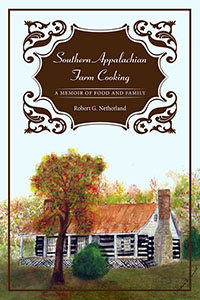Chances are you’ve enjoyed many a “farm-to-table” meal, perhaps at restaurants presided over by chefs of star stature, perhaps from your own kitchen. Eating locally and growing-your-own are hallmarks of life in the early twenty-first century, far past trend status; the value of a homegrown repast is well understood. But it’s strange how the way of life—and eating—known by rural Southerners as recently as fifty years ago feels exotic now, an era palpably distant from our own. In his memoir and cookbook, Southern Appalachian Farm Cooking, Robert G. Netherland reveals the textures and tastes of a bygone time and place, one where White Lily flour reigned supreme, butter was churned, tobacco crops provided extra cash for Christmas presents, and beans and cornbread were the basis of daily meals.
 Netherland grew up in the hills of East Tennessee, in a small town called Surgoinsville on the Holston River, roughly sixty miles north of Knoxville. Born in 1946, he first lived in a “large, rambling chestnut log house” on a sixty-acre farm with his parents and maternal grandparents; six years later, his father built the family their own home just across the yard. “Farm mechanization lagged behind other areas in the country,” Netherland recalls, “and I still remember my grandfather and father working the fields behind a mule or a team of horses…. Days were long and the work was constant if the farm were to produce what was needed to sustain a family year round.”
Netherland grew up in the hills of East Tennessee, in a small town called Surgoinsville on the Holston River, roughly sixty miles north of Knoxville. Born in 1946, he first lived in a “large, rambling chestnut log house” on a sixty-acre farm with his parents and maternal grandparents; six years later, his father built the family their own home just across the yard. “Farm mechanization lagged behind other areas in the country,” Netherland recalls, “and I still remember my grandfather and father working the fields behind a mule or a team of horses…. Days were long and the work was constant if the farm were to produce what was needed to sustain a family year round.”
But that labor-intensive life was lived in sturdy companionship with the earth. The family threshed wheat, grew tobacco, put up beans and tomatoes, made sorghum molasses and muscadine wine, and slaughtered hogs in the late fall. (That’s just a sampling.) Netherland also writes of country celebrations and “dinners on the ground,” when families gathered together around makeshift tables laden with covered dishes and desserts, forming a glorious Southern spread—one surely replicable with the guidance of the recipes included here. “[T]his cookbook is both a nostalgic and practical effort,” he writes. “Hear the stories, then dive into the recipes and prepare them with the same care that our mothers and grandmothers did, and you will be rewarded with mouth-watering food from the Southern Appalachian farm.”
It’s interesting to note how central breads and veggies are to the culinary tradition on display in Netherland’s book. The first chapter, titled oh-so-fetchingly “Biscuits, Biscuits, Biscuits,” contains no fewer than six recipes for the quintessential Southern sopper or sandwich-maker. And what comes next? Cornbread, naturally, complete with a mouth-watering description of an iron-skillet meal: “The skillet was seasoned so well from years of baking cornbread that the bread just fell onto the serving plate when the skillet was tipped over it. We would pass the bread at the table and break off a piece with our hands, then crumble a piece of cornbread into a glass of sweet milk or buttermilk, and eat it with a spoon or dip a wedge into a bowl of greens and pot likker and watch it soak up the liquid before popping it into our mouths.” Yes, please.
 Next comes a chapter on “Light Breads,” or any baked yeast bread. This section includes a recipe for dinner rolls that sound just like my grandmother’s rolls, which my mom makes for every holiday dinner, a Southern-food tradition that I can only hope to carry on.
Next comes a chapter on “Light Breads,” or any baked yeast bread. This section includes a recipe for dinner rolls that sound just like my grandmother’s rolls, which my mom makes for every holiday dinner, a Southern-food tradition that I can only hope to carry on.
In subsequent chapters, Netherland focuses on individual vegetables—beans, corn, potatoes, and more—before brief sections devoted to meats. (Here he includes, it must be noted, a recipe for fried squirrel should you be so inclined.) But by book’s end we return to the realm of the baked good, with recipes for Old Fashioned Molasses Cookies, White Layer Cake with Boiled Frosting, cobblers, and Mamaw’s Butterscotch Pie (which I will be trying as humanly soon as time allows). Clearly, we Southerners like our sweets and our gluten.
While many of the dishes here are incredibly simple—consider the delicious minimalism of “killed lettuce,” which is lettuce and spring onions with a warm dressing of bacon, cider vinegar, and salt and pepper—it’s also true that a good number require substantial care and time. It’s not hard to see why my mother’s generation was eager to cut corners where they could, with a can of soup or a store-bought crust; but this book offers dishes galore, and generous dollops of personal history, to please both adventurous and lazy Southern cooks. In preserving an all-but-forgotten way of life, Netherland’s memoir fits well on the shelf alongside Sean Brock’s Heritage, Frank Stitt’s Southern Table, and the groundbreaking books by Edna Lewis. Life on a Southern Appalachian farm was all consuming, Netherland shows us, but the payoffs could be great.

Susannah Felts is a writer, editor, and educator in Nashville, as well as co-founder of The Porch Writers’ Collective, a nonprofit literary center. She is the author of This Will Go Down On Your Permanent Record, a novel, and numerous journal and magazine articles.
Tagged: Nonfiction





